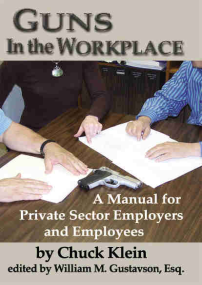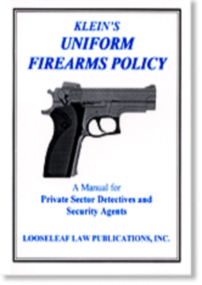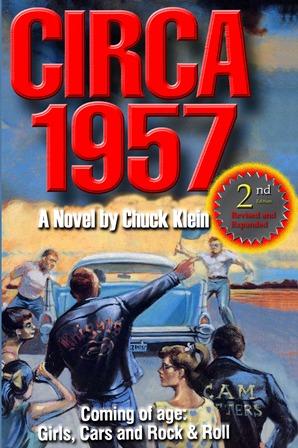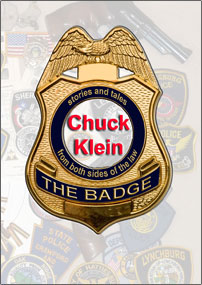
.jpg)

.jpg)





P.I. MAGAZINE
Selected published Columns
by Chuck Klein, Firearms Editor, 1990-2002
Page under construction
*****************************************************
KAHR ARMS FIELD TEST
The first thing one notices about this new entry into the arena of compact defensive pistols is this semi-auto looks good. It looks, feels and handles like a quality piece of machinery. The second observation, this is a full 9mm Luger - not a .380 ACP!
 Machinery, or more precisely, machine tools is what KAHR ARMS (pronounced: car) is all about. Saeilo, Inc., a leading supplier of computer numerical control (CNC) machine tools, is the parent company. Established in 1981 Saeilo, Inc. formed a new division in 1986 to specialize in contract machining, aerospace, automotive, electronics and small arms manufacturing. KAHR ARMS headquarters and slide production is in Blauvelt, NY while frame, barrel and small components, along with assembly operations, are handled at the company's Worcester, Massachusetts facility. Even though each integral part is subjected to statistical process Control and computerized inspection, all firearms are test fired prior to shipments. Test ammunition is an assortment of commercial rounds including +P and +p+ cartridges. Saeilo,Inc. maintains an extensive machine tool distribution network and four manufacturing plants strategically located throughout the USA.
Machinery, or more precisely, machine tools is what KAHR ARMS (pronounced: car) is all about. Saeilo, Inc., a leading supplier of computer numerical control (CNC) machine tools, is the parent company. Established in 1981 Saeilo, Inc. formed a new division in 1986 to specialize in contract machining, aerospace, automotive, electronics and small arms manufacturing. KAHR ARMS headquarters and slide production is in Blauvelt, NY while frame, barrel and small components, along with assembly operations, are handled at the company's Worcester, Massachusetts facility. Even though each integral part is subjected to statistical process Control and computerized inspection, all firearms are test fired prior to shipments. Test ammunition is an assortment of commercial rounds including +P and +p+ cartridges. Saeilo,Inc. maintains an extensive machine tool distribution network and four manufacturing plants strategically located throughout the USA.
The KAHR, model K9, is a double-action-only (DAO) semi-auto design which means the hammer is cocked and released with each pull of the trigger. Subsequently, there are no user operated safety levers, buttons or controls that must be activated before firing. All that is required to discharge the pistol (after manually functioning the slide to charge the chamber) is to pull the trigger - just like any double action revolver. The trigger pull is long, with about half the distance in slack take-up, before actual resistance to the main spring is encountered. From the point of hammer engagement the trigger pull is smooth, light (about 7#) and sans any creep or drag. Under combat conditions - during rapid fire - the take-up is not noticeable.
Ergonomically, and that's what personal protection is all about, the weapon is second to none. Pointability, the ability of the gun to point to where the shooter is looking without any digital readjustment, is right on target. Unlikesome of the other compact handguns on the market, felt recoil, thanks to wrap around two-piece soft polymer grips, is negligible. Though the gun is touted (by some gun writers) as being a pocket pistol, this investigator believes any firearm with a weight of more than 18 ounces precludes carry in all but the bulkiest of top coat pockets. Locations of the magazine release and slide stop are placed for ease and comfort of the right hand shooter.
Though not intended to be a "target" pistol, the KAHR K9, aside from being fun to shoot, is very accurate for a short barreled pistol. The test gun in the hands of this investigator produced fist sized groups at the 25 yard range. At combat distances of seven yards, shooting out the "X" ring was within the compact's capabilities. Of the 100 or so Winchester 115 gr. FMJ and Dynamit Nobel FMJ rounds fired there were no malfunctions, miss-feeds or anything other than flawless performance.
If any negative can be found it has to be with the take-down procedure. Disassembling the pistol for cleaning requires practiced dexterity and plenty of physical strength. Because the recoil spring is on the heavy side, due to such a compact design, holding the slide back while trying to extract the slide stop is quite difficult. However, if one has the use of a leather padded vise the task is easy and simplified.
Concealability, to the Private Investigator who must work undercover or in situations that require the epitome of inconspicuousness of a weapon is tantamount to any successful operation. The slab-sided and protrusionless KAHR ARMS powerhouse, when mated to a secure and form-fitted holster, will please the most paranoid of agents. With a capacity of eight +p+ 9mm rounds and sans having a fumble with a manual safety the KARR K9 is excellent protection in today's increasingly violent society.
SUMMARY:
Functioning like a revolver, but without the bulk and limited capacity of a wheel-gun or a single action semi-auto with it's manual external safety, the DAO self-loader is here to stay. Some of the other compact 9's, both currently available and those that have gone out of business, are designed to have a limited life, are hard to shoot and/or don't point naturally. With it's many attributes, plus being manufactured from solid steel on CNC and CAD state-of-the-art machine tools, the KAHR K9 is destined to be a classic and to hold it's resale value. And, besides, it's American made.
**********************************************************************************
LASER SIGHTS TEST
by Firearms Editor Chuck Klein
From P. I. MAGAZINE (Fall 1997)
With the help of prime-time TV dramas, LASER sighting devices have captured the police and public's imagination. Made-for-TV movies have depicted police counter-snipers at great distances imprinting a tiny red dot on the chest of the bad guy, who, with a look of horror, immediately surrenders. In a true case of life imitating art, there are many documented arrests where a perp immediately capitulated after seeing the police-activated red dot imprinted on his chest.
The term "LASER" is an acronym for "Light Amplification by Stimulated Emission of Radiation." The early LASER sights were cumbersome and heavy devices that require the services of a qualified gunsmith for installation. Today, thanks to a Portland, Oregon, manufacturer, the user-friendly LASER sights are as easy to install as a new set of handgrips.
Unlike some other makers, the Crimson Trace units do not require a special holster to accommodate obtrusions, wiring of any type or unique skills or installation tools. Crimson Trace builds their LASER sights into the gun grips.
This innovative design allows the user to merely change grips (one screw on most guns) to add LASER sighting capability. The genius of the CTC LASERGRIPS is that the LASER light switch and adjustment screws are all incorporated into a set of hard plastic grips, molded to fit each specific firearm. The switch is found on the front portion of the grip directly where the middle finger comes to rest. With a normal handhold the middle finger activates the switch, which emits a bright red/orange beam from the right side of the grip to just above the trigger finger.
 Regardless of the make of LASER sight manufacturer, LASERs are accurate, cool, neat, fun and of some benefit to the user. However, they are NOT a panacea. They are not a substitute for proper trigger management or any of the fundamentals of handgun shooting. If you tend to jerk the trigger or have trouble holding steady, LASER sights won't improve your scores. But, if you are a practiced shooter, LASER sights, under certain conditions, can dramatically improve your hit ratio. The key words, "certain conditions," include ambient light less than direct sunshine; distances between 7 yards and 25 yards; and proper sight adjustment.
Regardless of the make of LASER sight manufacturer, LASERs are accurate, cool, neat, fun and of some benefit to the user. However, they are NOT a panacea. They are not a substitute for proper trigger management or any of the fundamentals of handgun shooting. If you tend to jerk the trigger or have trouble holding steady, LASER sights won't improve your scores. But, if you are a practiced shooter, LASER sights, under certain conditions, can dramatically improve your hit ratio. The key words, "certain conditions," include ambient light less than direct sunshine; distances between 7 yards and 25 yards; and proper sight adjustment.
A number of police and sheriffs agencies have reported successful arrest/confrontations after installing the CTC LASERGRIP on their service weapons. Police work, unlike private investigator's duties, involve physically arresting and detaining law breakers. Most of the success reported by the law officers are reports of how the arrestee meekly surrendered after seeing the LASER beam reflecting off his own chest. Since P.I's use of a firearm are for defensive purposes, the intimidation factor is of limited value.
With a hefty price tag, one has to wonder why such a small and lightweight product costs so much when LASER pointers and other LASER sights cost as little as $20. The reasons are found in the lens. CTC uses very precision ground glass - not plastic which is prone to damage from dirt and gun cleaning solvents. Glass also resists distortion due to temperature changes. Lens grinding is what makes the difference between a child's toy binoculars and a Leupold rifle scope or a Nikkon camera lens.
One concern of any battery-powered product is the cost and availability of the battery. Though the lithium battery is touted to have up to a 5-year shelf life and 4-6 hours of on-time service, CTC recommends changing the power source - and cleaning the terminals - every six months. Some LASER sighting devices have been designed to use very expensive "hearing aid" batteries or special batteries available only from the manufacturer. A check with a local camera shop. found a ready supply of CTC's power source, the common photo battery, Duracell #2032, at $2.50 each (two required).
Combined with tactical and psychological advantages, Crimson Trace's third-generation LASER sights are rapidly gaining acceptance in the police world. They are an excellent supplemental sighting device. Any pistol or revolver equipped with both tritium night sights and CTC LASERGRIPS could yield the ultimate handgun.
| SPECIFICATIONS: |
POSITIVE FACTORS OF CTC LASER GRIPS: |
NEGATIVE FACTORS OF LASER SIGHTED FIREARMS. |
|
* Retail selling price: $259 - $399
* Power output: <5 mw. Class IlIa
Visible LASER Diode. (Not hazardous to the eyes during momentary exposure)
* Wavelength/Beam Color: 633 nm / Red/Orange
* Beam size (claimed): .5" @ 50', round
* Beam size (tested): .375 x .625 @ 50';
.125x .250@21' oblong
* Battery: Duracell #2032, Lithium, 2.5 to 3.5 Vd
|
* Easy installation. No special tools or skills needed.
* Three year unconditional warranty.
* Simplicity of design. No wires or
activation switches.
* Excellent for training and to improve shooting skills.
* Great aid for those with diminished
eyesight due to age or other conditions.
* Special holsters not require.
* Best for low light conditions where iron sights are not readily distinguishable.
* Installing CTC LASERGRIPS will
not void handgun manufacturer's warranty.
|
* Habitually relying on their use could be a disadvantage under bright light conditions or during close-quarter combat.
* Having to hold lightly to keep from
activating switch means it is easier for assailant to knock weapon from hand.
* Bright LASER light could "give
position away" during low-light combat
situation.
* Right side mounted sight causes
parallax problems whereas, as
distance increases, point of impact moves left of line of sight.
* Extra time needed to "find"
LASER on target.
|
Is There Time?
The primary concern for any sighting device, including factory iron sights, is:
Does use of the sight require time for alignment/location? Some form of sight usage is recommended, except under close-quarter situations where Instinct Combat Shooting tactics are preferred (see:INSTINCT COMBAT SHOOTING by Chuck Klein and P.I. MAGAZINE, Spring, 1994 issue).
To test for any time difference between looking for the common iron sight picture against searching for a LASER dot, a set of Crimson Trace grips was given to John Benner, Chief Instructor at TACTICAL DEFENSE INSTITUTE TDI.com (see P.I. MAGAZINE Fall, 1997 issue).
Instructor Benner utilized a PACT timer for his tests (shooter draws on a beep sound, which starts the timer. The time stops on the sound of a gunshot.)
All shots were fired from 20' at a 10" circle. Firearm was J-Frame Smith & Wesson, Holster: Milt Sparks Summer Special IWB - strong side draw. Starting position was from hands held at chest high in defensive position. All times are average time in seconds.
Draw to I-hand hold, 5 rds, iron sights: 1.24
Draw to I-hand hold, 5 rds, CTC LASERGRIPS: 1.80
Draw to 2-hand hold, 10 rds, iron sights: 1.28
Draw to 2-hand hold, 10 rds, CTC LASERGRIPS: 1.8
Instructor Benner required slightly over a half-a-second more time to score hits by using LASER sights. This extra time might not be fatal at distances out to the limit of the weapon. However, at the test range of seven yards a half second could prove very costly in the heat of a real firefight.
For more information or to order contact:
CRIMSON TRACE CORPORATION
1433 N.W. Quimby Street
Portland, Oregon 97209
1-800/442-2406; FAX 1-503/295-2225
www.crimsontrace.com
***********************************************************
TO CARRY OR NOT CARRY
by Former Firearms Editor Chuck Klein © 2019
From P. I. MAGAZINE (May/June 2019)
To Carry or Not to Carry Chuck Klein There are three types of professional private investigators: One that always carries a handgun for personal protection and the one that doesn’t – the third, I’ll get to later.
Being a P.I. involves far more danger than that of law enforcement officers - those with the power of arrest, backup and radio contact. As a P.I., even when not on assignment, running into a disgruntled past target could create a physical attack on you – or the family members you might be with at the time.
Back when I was attending the police academy one of my fellow recruits asked the OIC if we should carry our handguns while off-duty. His answer was so succinct, obvious and made such complete sense that not only have I lived it, but I’ve taught it in my classes and written it into my books and articles. The Norwood, Ohio police lieutenant said: “One either never carries a firearm, or one always carries, but one never sometimes carries."
In other words, if your mindset is that you are carrying, then you won’t be transmitting vibes of fear if your case requires projecting an aura that requires toughness. It naturally forces you to be in condition yellow at all times – aware of your surroundings. This personal persona of confidence is telegraphed by your posture, and the ability to look anyone in the eye with conviction.
Cops/PIs, per se, have that 6th sense – the innate ability to “read people”. But we also project a demeanor that ofttimes is discernable by criminals with animal-type instincts. In other words, the bad guys can read us too. Those who carry the power of life or death on their person, tend to transmit a self-preservation bearing. The only possible advantage to never carrying is not having to worry about being in a place that forbids possession of a lethal weapon – such as police stations, airports or schools.
When I moved to the downtown portion of Cincinnati, as a civilian and after 17 years of country living, I was saved by my projected image. On a warm summer evening, I decided to walk to my son’s home, about 8-10 blocks away. What I didn’t realize was my route took me through a high-crime neighborhood – one where tennis shoes hung from telephone and cable wires. The streets were lined with dilapidated rowhouses that only had a sidewalk between them and the curb. I was outfitted in shorts and a loose-fitting, button shirt covering a Colt .38, 2 1/2” Diamondback in a strongside holster. Sensing this was not a good plan, I walked down the middle of the narrow, garbage-strewn street. Approaching a cluster of drug-seller types, dressed in under-ware-exposing, prison-type garb, I looked them over - eye to eye. One of the gang-bangers stepped away from the group, smiled, showing a diamond studded tooth, and said, “What’s shakin’, officer.” I returned the smile while putting my finger to my lips in the classic “shhh” expression. Even though the hair on my neck was standing on end, and my back was now to them, I never broke stride. I hadn’t been an LEO for years, but I’m convinced my character said I was and that was enough to keep them at bay. My son drove me home later, using a different set of streets.
Though now retired, I spent 20 years as a licensed private investigator and had to use my concealed handgun on numerous occasions. Though, I never fired my gun, I wouldn’t be writing this today had I not had a firearm during those instances.
The aforementioned third type of P.I., the sometimes carrier, creates a conflict inasmuch as bluffing toughness or inadvertently walking into a restricted location while armed, and, of course, reaching for a gun when one isn’t there but is needed. Consider the person who straps on his protection, goes about his daily routine, comes home, stores his gun and then … a thug/past-target crashes into his home while the gun is … stored. Or, he forgot to pick-up the milk on the way home and slips out, with his young daughter holding his hand, for a quick run to the local stop & rob, sans his gun. “It’s just a quick trip, honey – we’ll be right back”. At the S&R he walks into a robbery/mass shooting in-progress where the robber/shooter is coming after him and his child….
Other than statutory restrictions, there is only one condition when you should never have your firearm on your body (or very close at hand) – when under the influence of anything that may impair your thinking. Yes, even in your own castle, it is best to carry, not only for the actual protection, but because it keeps you mindful that this power to protect is right where it should be. Besides, no child can get to it - if secure on your body.
Summary: If you can carry, do, because all the rules, statutes, restraining orders, 911 calls, hand to hand combat technics, aerosol spray Mace, run & hide or other pseudo protective measures will never equal the effectiveness of a firearm when faced with an unwarranted and deadly criminal attack.
Chuck Klein, Firearms Editor for P.I.Magazine from 1990-2002 is a former LEO, retired P.I., NRA Certified Firearms Instructor, active member: IALEFI and author of Guns In The Workplace, Instinct Combat Shooting and other firearm related books, columns and articles. He may be reached from his website: https://chuckklein.com
**************************************************************************************************************************
THE DRAW ON THE DROP
by Former Firearms Editor Chuck Klein © 2019
From P. I. MAGAZINE (Sep/Oct 2019)
In Joseph Wambaugh’s non-fiction book, Lines & Shadows (1), he describes undercover agents working the California/Mexico border deploying the draw-on-the-drop technique. Maybe technique is not the correct word inasmuch as the LEOs who implemented the tactic did so as a last resort. Their life-saving acts were do-or-die - improvise-as-you-go maneuvers more than planned procedure. The drop, of course, comes from old cowboy/film-noir crime novels and movies where the person pointing the gun would have the “drop” on you. To be more exact: drop your gun/wallet or I will shoot … or don’t reach for your gat or I’ll drop you.
The undercover cops cited by Wambaugh, who executed the maneuver, were investigating smuggling activities along the border and were dressed like their criminal counterparts and thus not identifiable as police officers. The shootings took place in remote areas with little more than ambient starlight and maybe a campfire – conditions that certainly favored the LEOs.
Trying to draw and fire before the guy with the drop can pull the trigger is not something to be considered lightly or at anytime other than under exigent circumstance. It’s a personal judgement call as in: will he just take my money and go away; or take it and shoot; or if you’re a woman, take my money and then shoot - after he rapes me?
P.I.s, like undercover cops, are usually working alone and with no ability to radio for backup. Contacting persons to serve process or interview who don’t want to be found can create the most dangerous of conditions. If the target realizes the consequences of your intent, he/she, just because you’re only a civilian, might be more inclined to snuff you out. Of course, and unlike law enforcement officers, pulling your defensive arm out as a precaution is in most locales a crime.
To survive the situation where a perp has a firearm pointed at you, the S.I.F.T. (Surprise, Intuition, Fear and Timing) technique might be your only option.
SURPRISE: Aside from visibility, surprise is a key element in being able to extract your gun, bring it to battery and fire an accurate shot(s) before the weapon pointed at you can be precisely discharged. Surprise correspondingly comprises the reality that the perp doesn’t know you are armed and your demeanor is non-threatening. Surprise is also that your adversary believes he/she is in control of the situation - though not necessarily complacent - but he/she is not expecting any response or confrontation from you at the exact moment you begin your move.
INTUITION: Though not something one can actively practice, per se, it is the subconscious knowledge that comes from the study of reading people and that gut feeling that - now is the time. Playing mind games by yourself hones this mental power such as imagining circumstances where you might have to draw-on-the-drop - an excellent method of creating a mindset that crafts survival instincts. In other words, your mindset plus abilities gained from practice and reality of the situation will intuitively signal when to take defensive action.
FEAR: A normal reaction to having a firearm pointed at you is fear. However, training to have a mindset to override this natural tendency is necessary to maintain a positive reaction. Thus, it is not fear that is important, but your ability to project fear while intuition generates your move. You must become an actor which is something you can practice so that when faced with the reality of an armed confrontation, your acting intuitively trumps real fear allowing you to control the situation. Many criminal types get-off on inducing fear in persons, thus they will begin to relax when they believe they control you because of your projected fear.
TIMING: This factor encompasses the interval whereas it takes time – maybe as long as a second or two - for anyone to react to a surprise, especially if they are under the influence of drugs or alcohol. In addition, timing requires distraction, an attribute that is most helpful in surviving a close-quarter-combat (CQC) firefight. A simple, “I have money (or drugs) in my pocket,” or looking over the perp’s shoulder and saying loudly, “officer,” just prior to beginning the reach toward your concealed gun might be sufficient distraction. However, you must be committed to make your move as the distraction is only for an instant and can usually be deployed only once. Timing, generally, is not something you can take your time with such as trying to verbally convince the threat to walk away – losers with nothing to lose can’t be bluffed. Again, it’s a judgement call based on your intuition.
The draw on the drop is executed as part of the S.I.F.T. compendium: As your hand reaches for your gun, a side-step move begins. In CQC conditions and with a gun pointed in your general direction or even dead-on your center mass, the advantage is yours if you move laterally while making the draw. Unless the perp is practiced at instinct combat shooting (2) – which you should be – his chance of missing is greatly enhanced if you are moving. Another option, but only at contact distances, is to grab the assailant’s weapon while drawing your own piece. Though you might get shot in the hand, it’s better than in the kill zone.
When I was instructing at Tactical Defense Institute (3) we ran one-on-one scenario training exercises such as the confrontation robbery. Here, a good-guy, armed with a concealed Simunition (4) loaded gun, was told to turn around (as if exiting an elevator) to face a man with a Simunition loaded gun pointed at him. The only instructions given secretly were to the robber – he was to say, “give me your money” and then silently count to five before shooting the guy with the concealed gun. The majority of good-guys would try to talk the shooter out of shooting. Very few attempted to draw-on-the-drop. Then the reality of our training began.
You never know when you might be confronted with a lethal force threat and all contingencies can’t be addressed or trained for, but basic mindset and practicing defensive moves is paramount to attacks of the heart-stopping kind.
(1) Accountings of the San Diego Department’s Border Crime Task Force https://www.amazon.com/dp/0688026192/ref=_ext_
(2) The tactic of learning to shoot by focusing on the target, INSTINCT COMBAT SHOOTING, rather than the sights. During CQC conditions, ofttimes there is not enough time to seek a sight picture or even look at your sights. https://www.chuckkleinauthor.com/Page.aspx/181/instinct-combat-shooting.html.
(3) TDI, A civilian, police and military training facility in SW Ohio https://www.tdiohio.com
(4) Non-lethal training ammunition https://www.simunition.com/. When struck by one of the rounds it stings, thus adding reality to the simulation of a firefight.
Chuck Klein is a former LEO, NRA Certified Police Firearms Instructor and author of many police and firearm related books and articles. https://chuckklein.com